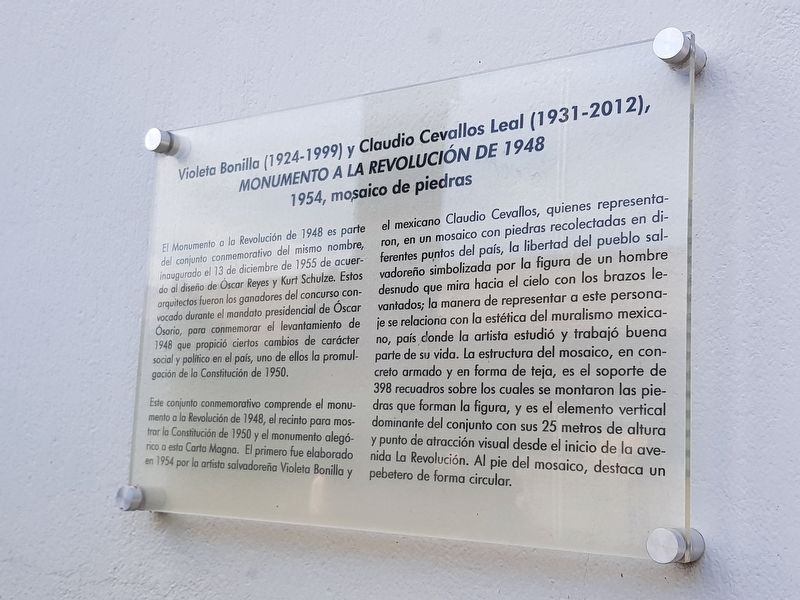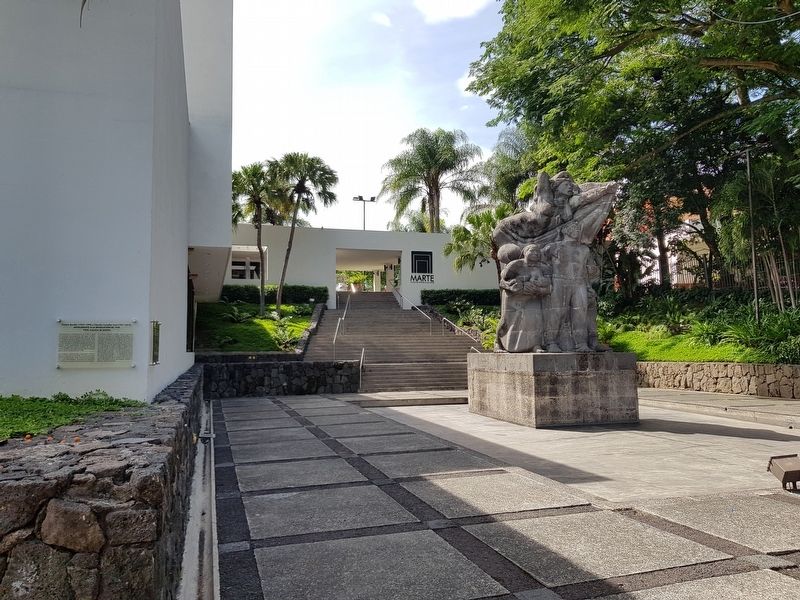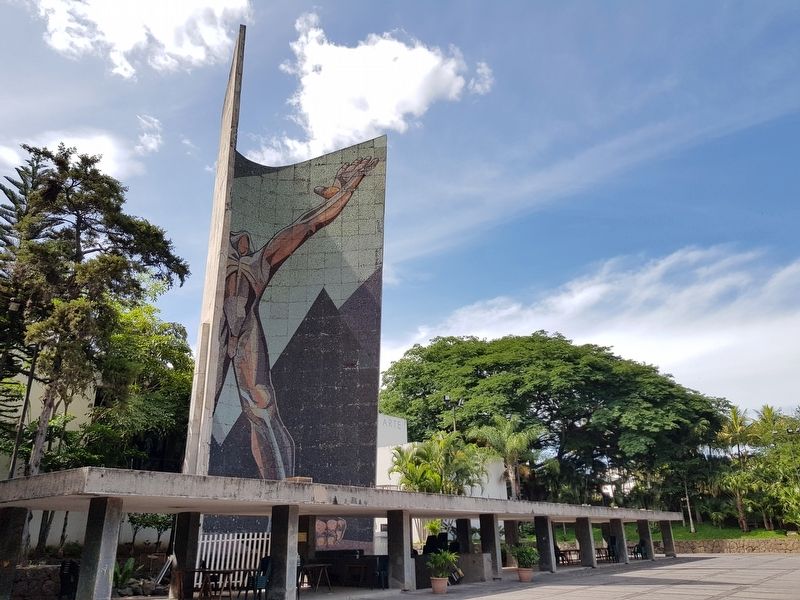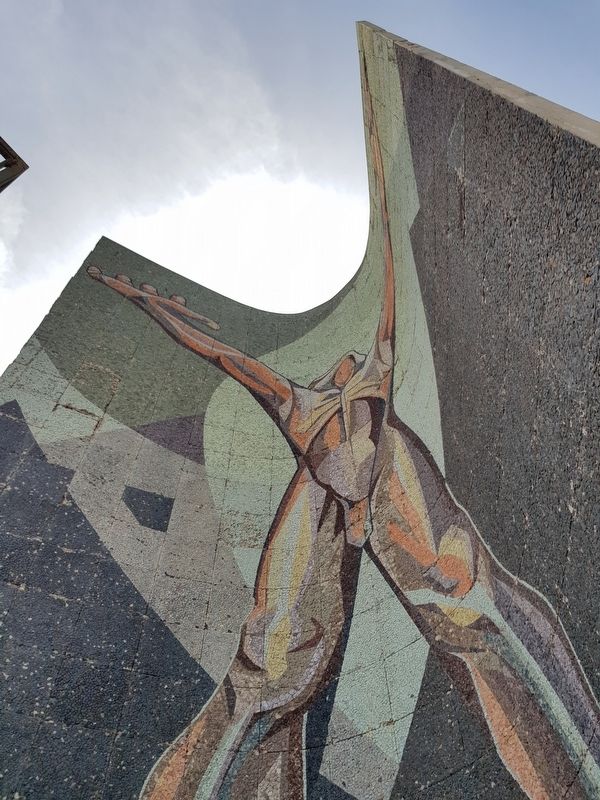San Salvador, El Salvador — Central America (West Coast)
Monument to the Revolution of 1948
Monumento a la Revolución de 1948
Violeta Bonilla (1924-1999) y Claudio Cevallos Leal (1931-2012),
1954, mosaico de piedras
El Monumento a la Revolución de 1948 es parte del conjunto conmemorativo del mismo nombre, inaugurado el 13 de diciembre de 1955 de acuerdo al diseño de Óscar Reyes y Kurt Schulze. Estos arquitectos fueron los ganadores del concurso convocado durante el mandato presidencial de Óscar Ósorio, para conmemorar el levantamiento de 1948 que propició ciertos cambios de carácter social y politico en el país, uno de ellos la promulgación de la Constitución de 1950.
Este conjunto conmemorativo comprende el monumento a la Revolución de 1948, el recinto para mostrar la Constitución de 1950 y el monumento alegórico a esta Carta Magna. El primero fue elaborado en 1954 por la artista salvadoreña Violeta Bonilla y el mexicano Claudio Cevallos, quienes representaron, en un mosaico con piedras recolectadas en diferentes puntos del país, la libertad del pueblo salvadoreño simbolizada por la figura de un hombre desnudo que mira hacia el cielo con los brazos levantados; la manera de representar a este personaje se relaciona con la estética del muralismo mexicano, país donde la artista estudió y trabajó buena parte de su vida. La estructura del mosaico, en concreto armado y en forma de teja, es el soporte de 398 recuadros sobre los cuales se montaron las piedras que forman la figura, y es el elemento vertical dominante del conjunto con sus 25 metros de altura y punto de atracción visual desde el inicio de la avenida La Revolución. Al pie del mosaico, destaca un pebetero de forma circular.
Monument to the Revolution of 1948
Violeta Bonilla (1924-1999) and Claudio Cevallos Leal (1931-2012)
1954, stone mosaic
The Monument to the Revolution of 1948 is part of the memorial complex of the same name, inaugurated on December 13, 1955 according to the design of Oscar Reyes and Kurt Schulze. These architects were the winners of the contest convened during the presidential term of Óscar Ósorio to commemorate the 1948 uprising that led to certain social and political changes in the country, one of them the promulgation of the 1950 Constitution.
This memorial complex includes the Monument to the Revolution of 1948, the enclosure to exhibit the Constitution of 1950 and the allegorical Monument to the Constitution. The first was prepared in 1954 by the Salvadoran artist Violeta Bonilla together with the
Mexican artist Claudio Cevallos, who represented, in a mosaic with stones collected from different parts of the country, the freedom of the Salvadoran people symbolized by the figure of a naked man who looks towards the sky with his arms raised. The representation is related to the aesthetics of Mexican muralism, a country where the artist studied and worked a good part of her life. The mosaic structure, specifically reinforced and curved, is supported by 398 frames on which the stones that form the figure were mounted. The figure is the dominant vertical element of the complex at 25 meters high. It is a landmark of the city and can be seen from the beginning of the Avenue of the Revolution. At the foot of the mosaic, a circular eternal flame cauldron stands out.
Topics. This historical marker is listed in these topic lists: Arts, Letters, Music • Government & Politics • Patriots & Patriotism • Wars, Non-US. A significant historical date for this entry is December 13, 1955.
Location. 13° 41.558′ N, 89° 14.505′ W. Marker is in San Salvador. Marker is at the intersection of Calle Circunvalación and Avenida de la Revolución, on the right when traveling west on Calle Circunvalación. Touch for map. Marker is in this post office area: San Salvador 01101, El Salvador. Touch for directions.
Other nearby markers. At least 8 other markers are within walking distance of this marker. Allegory to the Constitution of 1950 (a few steps from this marker); Valero Lecha (within
shouting distance of this marker); Claudia Lars (within shouting distance of this marker); Agustín Barrios (within shouting distance of this marker); Pancho Lara (within shouting distance of this marker); Salarrué (within shouting distance of this marker); General Francisco de Paula Santander (approx. 0.4 kilometers away); Inca Garcilaso de la Vega (approx. half a kilometer away). Touch for a list and map of all markers in San Salvador.
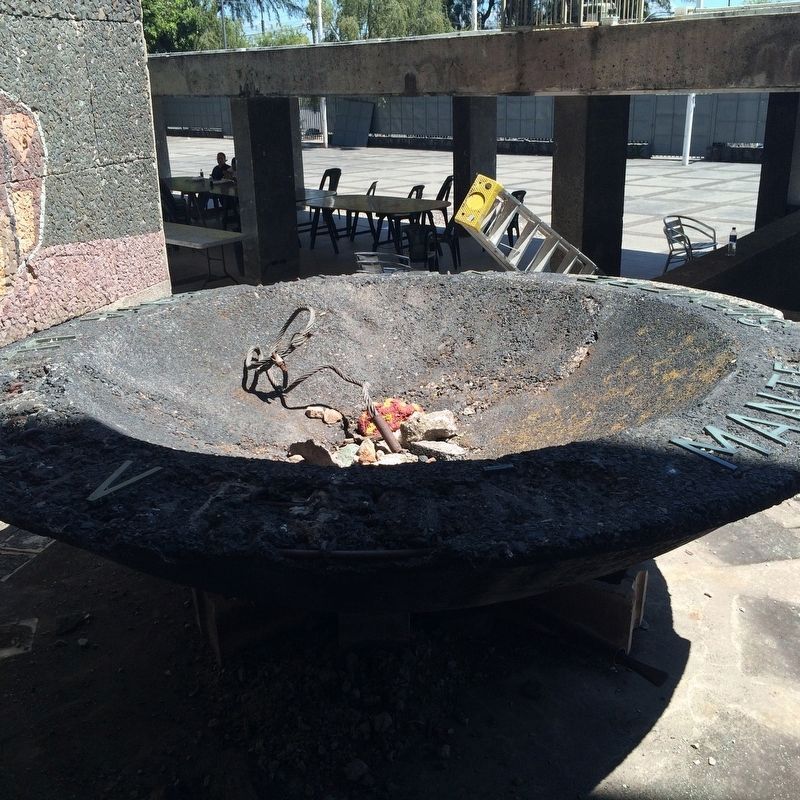
Photographed By J. Makali Bruton, February 21, 2015
5. The 'eternal flame' of the Monument to the Revolution of 1948
The monument's eternal flame cauldron originally had bronze lettering around its edge that read "Mantengan siempre encendida ésta llama" or "Keep this flame always lit," referring to the ideals of the Revolution of 1948. Most of the letters have been stolen.
Credits. This page was last revised on March 20, 2024. It was originally submitted on August 7, 2019, by J. Makali Bruton of Accra, Ghana. This page has been viewed 435 times since then and 87 times this year. Photos: 1, 2, 3, 4, 5. submitted on August 7, 2019, by J. Makali Bruton of Accra, Ghana.
